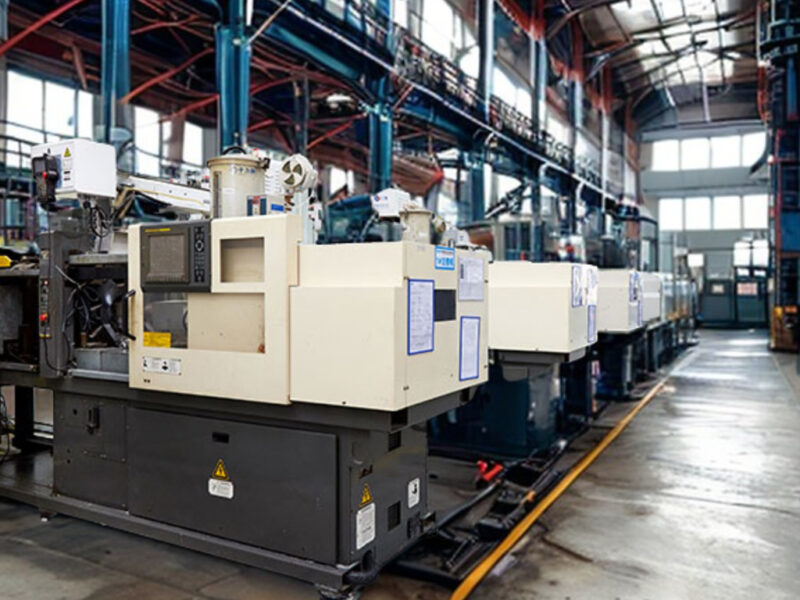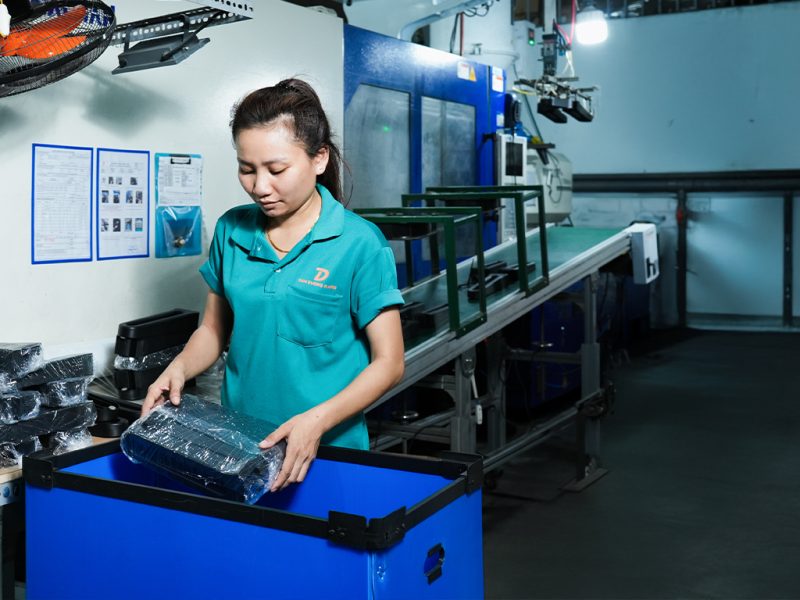
Plastic injection molding is one of the core manufacturing technologies in the modern plastics industry. In the article below, Thai Duong Plastics provides a comprehensive overview of its working principles, machine structure, factors affecting product quality, and practical applications of injection molding technology.
What is Plastic Injection Molding?
Plastic injection molding is a plastic processing method in which thermoplastic resin is melted and then injected into a mold under high pressure. The molten plastic fills the mold cavity, cools, and solidifies to form a product with a predefined shape. The entire process is quick, fully automated, and ensures high production efficiency and consistent product quality.
This technology requires precision molds and specialized injection molding machines. Depending on technical requirements, plastic materials used may include polyethylene, polypropylene, ABS, PC, etc.—all of which must have good flowability, high molding capability, and thermal stability during processing.

Key Advantages and Applications
Injection molding offers numerous advantages for businesses and manufacturers:
- High efficiency: Large-scale production cycles can be completed in a short time.
- Consistent accuracy: This technology ensures products meet exact shape and size specifications.
- Compatible with various plastics: Usable with virgin resin, recycled plastic, engineering plastics, and more.
- Cost-effective for mass production: Although initial investment in molds and machines is high, unit cost per product is low when produced in bulk.
- Easy automation: Can be integrated with robots, quality inspection systems, packaging lines, etc.
Thanks to these advantages, injection molding is widely applied in electronics, healthcare, consumer goods, food packaging, and automotive industries—especially for complex parts requiring high technical and aesthetic standards.
Technology and Operation Process of Injection Molding
The injection molding process consists of five main steps:
Step 1: Plastic pellets are loaded into a hopper and then fed into a heated barrel with a rotating screw. Here, the plastic is melted to the desired fluid state.
Step 2: Once melted, the screw pushes the plastic into the mold cavity under high pressure. This stage requires precise control of speed and pressure to ensure complete mold filling.
Step 3: After filling, the holding pressure phase compensates for shrinkage while the part cools. Integrated mold cooling systems help the plastic solidify quickly.
Step 4: The mold opens, and the product is ejected by an ejector system, which must be carefully designed to avoid product deformation.
Step 5: Post-ejection processes such as trimming, quality inspection, coating, or assembly may follow, depending on the application.

Basic Structure of an Injection Molding Machine
An injection molding machine typically consists of three main systems:
- Injection Unit: Includes the hopper, screw, heater barrel, and nozzle—where the plastic is melted and injected.
- Clamping Unit: Includes the clamp frame and movable platen, which hold the mold tightly during molding and cooling.
- Control System: Allows operators to monitor and adjust parameters such as temperature, pressure, holding time, and injection speed.
Currently, three types of machines are widely used: hydraulic, electric, and hybrid. Each type has unique advantages regarding clamping force, speed, precision, and energy efficiency—tailored to different production needs.
Read more: Structure, types, and applications of injection molds
Technological Trends Affecting Injection Molding Quality
To meet technical standards, it is crucial to optimize the following factors:
- Mold design directly affects the accuracy and surface finish of the product. Molds must be precisely machined with proper venting, efficient cooling, and well-designed ejection systems.
- Processing parameters like barrel temperature, injection pressure, holding time, and cooling duration must be closely monitored throughout the cycle.
- Each plastic type has different flow rates, shrinkage, and heat resistance—affecting final product properties. Choosing the right material is essential.
- Environmental conditions such as temperature, humidity, and equipment stability also influence product consistency and durability, especially in continuous production.

Automation is an emerging trend in the injection molding industry. Manufacturers are increasingly integrating robotics and monitoring systems to enhance efficiency, reduce labor costs, and improve quality control.
Digital control and device connectivity help ensure machine stability, energy savings, and timely error detection. Meanwhile, the rise of recycled materials, bioplastics, and green manufacturing is pushing the industry toward more sustainable injection molding processes.
Comparison of Injection Molding with Other Manufacturing Methods
Injection molding is the optimal solution for high-volume production of precision plastic parts. However, depending on specific requirements, other methods may also be considered:
| Method | Advantages | Limitations |
| Injection Molding | High accuracy, suitable for mass production, fast cycle time, low unit cost | High initial cost for molds and machines, not ideal for low-volume runs |
| 3D Printing | Rapid prototyping, no mold required, ideal for custom parts | Slow speed, not suitable for mass production, limited material strength |
| Blow Molding | Efficient for hollow items like bottles, lightweight products | Limited in shape complexity, not ideal for precision parts |
| Thermoforming | Suitable for thin products, material-saving | Cannot produce complex features, surface prone to distortion |
| CNC Machining | Extreme precision, works well with metal and engineering plastics | High cost, low throughput, inefficient for mass production |
| Compression Molding | Good for reinforced materials, large components | Long cycle time, high pressure required, limited design options |
Injection molding is an effective solution for producing both technical and consumer plastic products. The technology meets high standards for precision, speed, and cost-effectiveness. As automation continues to evolve, injection molding plays an increasingly vital role in modern manufacturing. If your business seeks expert consultation on plastic processing, contact Thai Duong Plastics for comprehensive support.
Learn more: What is plastic molding?
